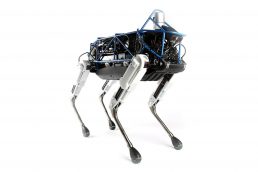
Among many other subjects, the late, great Hunter S. Thompson was one of the world’s foremost experts on weirdness of all kinds. One of our favorite — and more often quoted — observations from Dr. Gonzo on the subject is a good catch-all for when it seems the world is not making sense:
“When the going gets weird, the weird turn professional.”
But this week we actually have another favorite in mind — from later in Thompson’s career:
“It never got weird enough for me.”
Given the amount of mayhem and chaos Thompson personally took credit for causing, that admission alone is fairly shocking. It may be the case that there was no amount of weirdness that would have been enough for Hunter S. Thompson.
However, the last few weeks of action in payments and commerce has convenience of a plausible other explanation: He didn’t live long enough to see retail reinvention in the digital age.
In the face of infinitely informed consumers, Amazon being everywhere and consumers wanting to be able to buy everything everywhere whenever they feel like it — well, things have gotten more than tough for retailers: they’ve just gotten plain weird. Everyone wants to build the best consumer experience. Ideas for how to concretely do that, other than getting a job at Amazon, are few and far between.
So the weird have gone pro and out-of-the-box thinking abounds. Some of it works; disruptive innovation depends on thinking a little bit differently. Some of it, however, does not — because there is such a thing as too different.
For example…
Dirty Clothes Are the New Black?
Okay, before we dig into what might be Nordstrom’s worst fashion faux pas ever, we want to note that bad ideas about blue jeans have abounded this year.
Expensive bad ideas.
Barney’s is selling “inside-out jeans” for nearly $1,000, and Levi’s is selling what it calls “bare-butt” jeans for $1,260. We’d include a picture, but this is a family publication. Suffice to say, bare-butt jeans are exactly what they sound like.
We also want to note that distressed jeans are not a new idea. Ripped jeans were the height of style in the 1990s, and there is a good reason for that. They are totally awesome.
But ripped and filthy are not the same things — a distinction someone failed to explain to Nordstrom before they started selling actual mud-encrusted jeans on their website for the consumer who wants to look like they fought a hobo for their pants.
And who wants to spend a lot of money doing it, because the jeans cost $425.
According to Nordstrom’s description, the jeans are:
“Heavily distressed medium-blue denim jeans in a comfortable straight-leg fit, embody rugged, Americana workwear that’s seen some hard-working action with a crackled, caked-on muddy coating that shows you’re not afraid to get down and dirty.”
That description has the dual benefits of being silly-sounding — and also totally false. If one were not afraid to get down and dirty, they would not buy a pair of pre-soiled $425 jeans. They would buy $25 jeans at Walmart and then go and actually get down and dirty.
And this story gets funnier in at last two regards. Nordstrom may have failed to boost buzz for their edgy merchandise with the run of dirty jeans, but they did manage to give Reebok a bit of a boost. A day or so after the various stories about the soiled designer jeans made the rounds, Reebok began advertising their own parodic version of the jeans: a pre-sweated t-shirt.
The better punchline? Amazon still undercut them on price. The same jeans can be had for $99-$202 and arrive at your door in two days.
So that one didn’t work — but not all kinds of gross products are a bad idea, per say…
The Unicorn Frappuccino — Because Tasting Good Isn’t Everything
By now you’ve seen the picture: pink, blue, iridescent and sparkly — the Unicorn Frappuccino looked something like a Lava Lamp you can drink.
Well, you can drink it if you have a taste for a beverage that was described at times as “disgustingly sweet,” “unnatural in all ways,” and reminiscent of “the taste of sour birthday cake and shame.”
How does one achieve the look of a lava lamp and the taste of shame? According to Starbucks, the drink is “made with a sweet dusting of pink powder blended into a crème Frappuccino with mango syrup, and layered with a pleasantly sour blue powder topping,” according to a news release. It changes colors from purple to pink when you stir in “swirls of blue.”
Pink is not a flavor. Blue is not a flavor.
They are colors.
And, according to most people who drank it, they are not tasty colors. It is notable that the Unicorn Frappuccino was released on 4/20 — an unofficial holiday for stoned people with the munchies, and even they didn’t think it tasted good.
But then, taste was not the primary concern at The Washington Post.
“This drink exists only to be Instagrammed, hashtag unicorn emoji, hashtag magical.”
And magical it was — particularly for Starbucks’ bottom line. The drink was so popular it often sold out, and baristas took to social media tearfully begging people to stop ordering it.
There will likely be more.
“Just stay tuned, because we have a lot more coming,” former CEO Howard Shultz said during an earnings conference call Thursday.
Schultz said that the pink-and-blue drink drove significant traffic to chains during its limited run, and noted that said sales will be more apparent in the company’s Q3 results. These sales will likely be seen in the company’s fiscal third-quarter earnings.
And where there is success, there is repetition.
“We will bring at least one … entirely new drink into Happy Hour this year that is going to be as good as Unicorn or better,” Starbucks CEO Kevin Johnson said, referring to the chain’s coming-soon promotion of half-priced fraps to customers from 3:00 pm to 5:00 pm.
Pray for the baristas.
And finally…
Robot Dog Deliveries (From Your Childhood Nightmares)
Dogs have a long history delivering things, as fetch is one of their favorite things to do. So in some sense, it is not surprising that the team at Boston Dynamics chose a dog to be their robotic delivery beast.
And “Spot,” is out there, programmed to deliver packages to consumers’ front doors.
Spot is Boston Dynamics’ attempt to branch out some — since before being bought by Google, its robots were largely funded by military contracts. But these days, Marc Raibert says the company has been testing how it can put its robots to work in more marketable ways.
During a recent talk at TED 2017, Raibert showed a video of Spot delivering a package strapped to its back to someone’s front door.
“We’ve been taking our robot to our employees’ homes to see whether we could get in the various access ways,” said Raibert onstage at TED. “We’re doing very well — about 70 percent of the way.”
So will it work?
Well, we think they may have a small problem.
This is what a dog looks like:

This is what Spot looks like:

We suspect if you show an average consumer a picture of Spot and ask if it is
A. A Dog
B. A Delivery Robot
C. A prototype of the xenomorph being used in the Alien prequel due out in theaters later this year
D. Something they’d never want to see at their front door
No one would say A, and no one who didn’t work for Boston Dynamics would say B.
We’re not experts — we’re just saying that in the early days of robotic delivery, when people are already a little nervous, it’s probably best not to send anything to customers’ doors that could be mistaken for a movie monster come to life. No matter what it is delivering, even odds someone is going to try to kill it with fire.
The lesson this week? Weird can work — tie-dye beverages can bring a people together, even if they don’t actually taste good. Or weird can fail — by being too gross to be edgy, or too scary to expose the public too.
And, of course, weird is transitory — for all we know, a year from now Spot will be delivering all our Day-Glo Frappuccinos, though we prefer to believe the mud-caked jeans thing isn’t going to catch on.
But we could be wrong. After all, area expert on weirdness Hunter S. Thompson also famously noted:
“Yesterday’s weirdness is tomorrow’s reason why.”